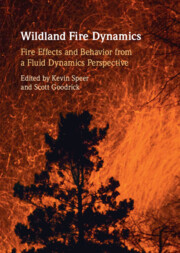Book contents
- Wildland Fire Dynamics
- Wildland Fire Dynamics
- Copyright page
- Contents
- Contributors
- 1 Wildland Fire Combustion Dynamics
- 2 The Structure of Line Fires at Flame Scale
- 3 Energy Transport and Measurements in Wildland and Prescribed Fires
- 4 Fire Line Geometry and Pyroconvective Dynamics
- 5 Firebrands
- 6 Re-envisioning Fire and Vegetation Feedbacks
- 7 Wind and Canopies
- 8 Coupled Fire–Atmosphere Model Evaluation and Challenges
- Index
- References
7 - Wind and Canopies
Published online by Cambridge University Press: 16 June 2022
- Wildland Fire Dynamics
- Wildland Fire Dynamics
- Copyright page
- Contents
- Contributors
- 1 Wildland Fire Combustion Dynamics
- 2 The Structure of Line Fires at Flame Scale
- 3 Energy Transport and Measurements in Wildland and Prescribed Fires
- 4 Fire Line Geometry and Pyroconvective Dynamics
- 5 Firebrands
- 6 Re-envisioning Fire and Vegetation Feedbacks
- 7 Wind and Canopies
- 8 Coupled Fire–Atmosphere Model Evaluation and Challenges
- Index
- References
Summary
This chapter aims to summarize current knowledge regarding the fluid dynamics of wind in canopies and to emphasize aspects that are the most relevant in the context of forest fires. We describe the main characteristics of wind flows in the lower part of the boundary layer, starting from the main features in homogeneous canopies, including velocity and turbulence profiles and characteristics of turbulent structures. Then we address two specific cases of heterogeneous canopies, the clearing-to-forest and the forest-to-clearing transitions, which have been extensively studied. The next section is dedicated to wind flow modeling and how such modeling is used in fire models. Finally, special focus is placed on wind measurement in the context of fire experiments. In this chapter, the feedbacks of fire on wind, as well as atmospheric stability, are not addressed. More information on these topics can be found in Chapters 4 and 8, respectively.
- Type
- Chapter
- Information
- Wildland Fire DynamicsFire Effects and Behavior from a Fluid Dynamics Perspective, pp. 183 - 208Publisher: Cambridge University PressPrint publication year: 2022



